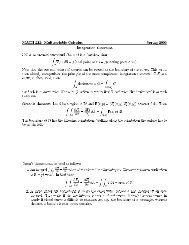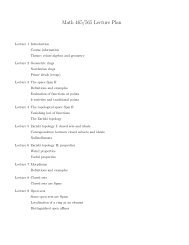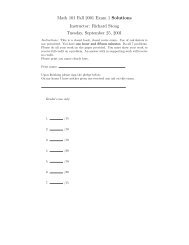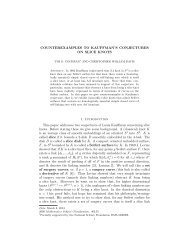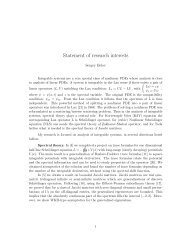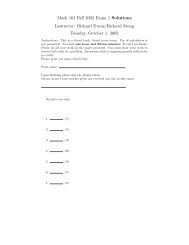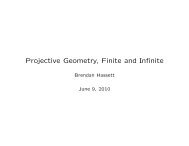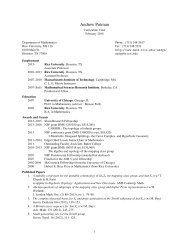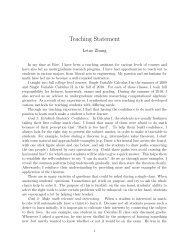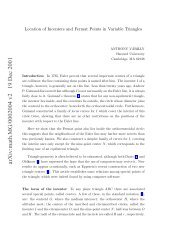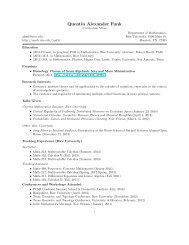MATH 465/565: Homework 5
MATH 465/565: Homework 5
MATH 465/565: Homework 5
You also want an ePaper? Increase the reach of your titles
YUMPU automatically turns print PDFs into web optimized ePapers that Google loves.
<strong>MATH</strong> <strong>465</strong>/<strong>565</strong>: <strong>Homework</strong> 5<br />
Due Friday, February 18, 2011<br />
You should try to do as many of these problems as possible, but write up and turn in solutions<br />
to exactly six of them. We work over an algebraically closed field k. Problems 3 and 6 will appear<br />
again on the next homework (turn in each at most once).<br />
1. Show that the quasiprojective variety A 2 \{(0, 0)} is not isomorphic to a closed subset of A n .<br />
[Hint: use the Nullstellensatz for affine varieties.]<br />
2. (a) Show that the Zariski topology on A n i ⊂ P n agrees with the subspace topology induced<br />
by the Zariski topology on P n .<br />
(b) Show that an affine variety U ⊆ A n i ⊂ P n is irreducible if and only if its projective closure<br />
U ⊆ P n is irreducible.<br />
(c) Show that the operation of projective closure defines a one-to-one correspondence between<br />
the closed subsets of A n i and the closed subsets of P n no irreducible component of which<br />
is contained in the hyperplane “at infinity” defined by X i = 0.<br />
3. Prove that every rational map from P 1 to P n is regular.<br />
4. Prove that any regular map f: P 1 → A n maps P 1 to a point.<br />
5. The twisted cubic in P 3 is the image of P 1 under the degree 3 Veronese map, ν 3 (P 1 ), where in<br />
homogeneous coordinates we write:<br />
ν 3 ([X 0 , X 1 ]) = [X 3 0, X 2 0X 1 , X 0 X 2 1, X 3 1].<br />
(a) Show that ν 3 (P 1 ) is the locus of common zeros of the three polynomials F 1 = Z 0 Z 2 − Z 2 1,<br />
F 2 = Z 0 Z 3 − Z 1 Z 2 , and F 3 = Z 1 Z 3 − Z 2 2, where [Z 0 , Z 1 , Z 2 , Z 3 ] are the homogeneous<br />
coordinates on P 3 .<br />
(b) Find the irreducible components of the common zero locus of each of the pairs {F 1 , F 2 },<br />
{F 2 , F 3 }, and {F 1 , F 3 }.<br />
6. Let f : P 2 P 2 be the rational map defined by<br />
f([X 0 , X 1 , X 2 ]) = [X 1 X 2 , X 0 X 2 , X 0 X 1 ].<br />
(a) Show that f defines a birational map from P 2 to itself.<br />
(b) At which points is f not regular? At which points is f −1 not regular?<br />
(c) Find non-empty open sets U, V ⊆ P 2 so that f restricts to an isomorphism U → V .<br />
7. Show that the Veronese image ν d (P n ) ⊂ P N is not contained in any hyperplane of P N .<br />
8. Show that any d + 1 points of the rational normal curve ν d (P 1 ) ⊂ P d span all of P d .<br />
9. Show that if X ⊆ P 2 is a plane conic, then P 2 \X is isomorphic to an affine variety.
[Hint: use the Veronese embedding.]<br />
10. (Extra Credit) A finite set S ⊂ P n is in (linear) general position if for any 0 ≤ l ≤ n, the linear<br />
span of any l + 1 points p 0 , . . . , p l ∈ S is a P l (i.e. no three points on a line, no four points in<br />
a plane, etc.).<br />
(a) Show that if S ⊂ P n is any collection of d ≤ 2n points in general position, then S is the<br />
set of common zeros of a collection homogeneous polynomials of degree 2.<br />
(b) Show that if p 1 , . . . , p 2n+1 are any 2n + 1 points on the rational normal curve ν n (P 1 ) ⊂ P n ,<br />
then p 1 , . . . , p 2n+1 are in general position, but any homogeneous polynomial of degree 2<br />
that vanishes on all the p i must vanish on all of ν n (P 1 ).<br />
(c) Generalize parts (a) and (b) to polynomials of degree m.<br />
11. (Extra Credit)<br />
(a) Show that the subring k[xy, xy 2 , xy 3 , . . .] ⊆ k[x, y] is not a finitely generated k-algebra.<br />
(b) Show that any sub-k-algebra of k[x] is finitely generated as a k-algebra.<br />
2



